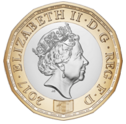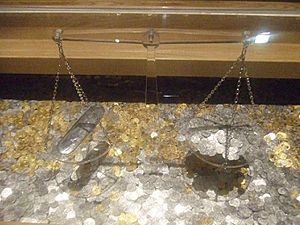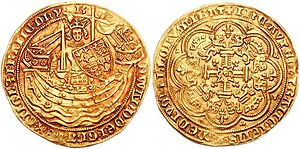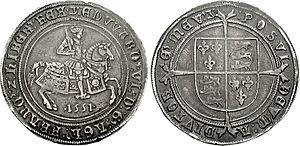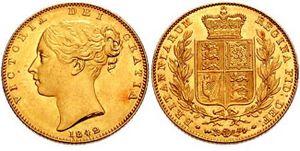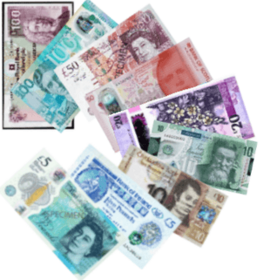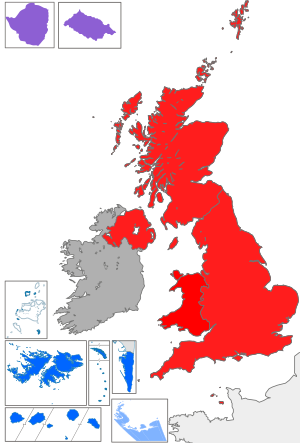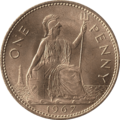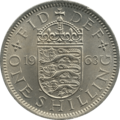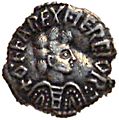Pound sterling facts for kids
Quick facts for kids Sterling |
|||||
|---|---|---|---|---|---|
|
|||||
| ISO 4217 Code | GBP | ||||
| User(s) |
|
||||
| Inflation | 3.1% or 2.2% | ||||
| Source | Office for National Statistics, 14 August 2024 | ||||
| Method | CPIH or CPI | ||||
| Pegged by | see Pound sterling § Notes | ||||
| Subunit | |||||
| 1⁄100 | penny | ||||
| Symbol | £ | ||||
| penny | p | ||||
| Plural | pounds | ||||
| penny | pence | ||||
| Coins | |||||
| Banknotes | |||||
| Freq. used | |||||
| Rarely used | |||||
| Printer | De La Rue | ||||
Sterling (also known as the British pound or pound sterling) is the official money of the United Kingdom. It is also used in nine other places connected to the UK. The main unit of sterling is the pound (symbol: £).
Sterling is the oldest currency in the world that has been used continuously. In 2022, it was the fourth most-traded currency globally. This means it was bought and sold a lot in money markets. It was only behind the US dollar, the euro, and the Japanese yen.
The Bank of England is the main bank for sterling. It prints its own banknotes. It also makes rules for other banks in Scotland and Northern Ireland that print their own banknotes.
Contents
- Understanding Sterling: Names and Symbols
- Sterling in Other Places: Crown Dependencies and British Overseas Territories
- How Sterling is Divided: Old and New Systems
- A Look at Sterling's History (600–1945)
- Early Anglo-Saxon Times
- Medieval Period: 1158
- Edward III: 1351
- Henry IV: 1412
- The Great Slump: 1464
- Tudor Period: 1551
- From 1601 to 1816
- The Bank of England and Modern Currency
- Currency of Great Britain (1707) and the United Kingdom (1801)
- Sterling in the British Empire
- The Gold Standard
- World War I: Gold Standard Suspended
- Between the World Wars: Gold Standard Returns, Then Leaves
- World War II
- Sterling's Journey (1946–Present)
- Coins of the Pound Sterling
- Banknotes of the Pound Sterling
- How Monetary Policy Works
- Legal Tender and Different Issues
- The Value of Sterling Over Time
- Exchange Rate and Global Use
- Images for kids
- See also
Understanding Sterling: Names and Symbols
Sterling is the name for the whole currency system. Pound and penny are the names for the units of money. Think of it like how renminbi is the currency of China, but yuan is the unit.
Where Did the Name "Sterling" Come From?
There are a few ideas about where the word "sterling" came from. One popular idea is that it comes from an old English word, steorra, meaning "star." With the ending -ling, it means "little star." This might be because the silver pennies used in England long ago had a small star on them.
Another idea links it to merchants from the Baltic Sea area, called "Easterlings." Their money was known for being good quality. English traders supposedly asked to be paid in "pounds of the Easterlings," which became "sterling." However, experts think this is less likely.
The word pound comes from the Latin phrase lībra pondō. Lībra means 'pound' (as in weight), and pondō means 'by weight'. So, a "pound sterling" originally meant a certain weight of sterling silver.
What Does the Pound Symbol (£) Mean?
The symbol for the pound is £. You might see it with one or two bars. The Bank of England has used the single bar since 1975.
Historically, people used a simple capital 'L' (like  ) before the numbers. Or they used an italic l. after them. The 'L' comes from the Latin word libra, which was a Roman unit of weight. A "pound sterling" was literally a pound (weight) of sterling silver.
) before the numbers. Or they used an italic l. after them. The 'L' comes from the Latin word libra, which was a Roman unit of weight. A "pound sterling" was literally a pound (weight) of sterling silver.
When people talk about money, they usually just use £ (for example, £12,000). If it needs to be super clear, they might use "GBP" (like GBP 12,000).
What is the Currency Code "GBP"?
The official code for sterling is "GBP." This code comes from "GB" for Great Britain and "P" for pound.
Sometimes, in old records or banking, you might see "stg" used for sterling. On the London Stock Exchange, some stocks are priced in "penny sterling," using the unofficial code "GBX."
What is "Cable" in Money Talk?
In the world of money trading, the exchange rate between sterling and the US dollar is called "cable." This name came about because, in the mid-1800s, this exchange rate was sent across the Atlantic Ocean using underwater telegraph cables.
Slang Terms for the Pound
A common slang word for the pound is "quid." It can be used for one pound or many pounds (e.g., "five quid"). The word "nicker" is another slang term for a pound.
Sterling in Other Places: Crown Dependencies and British Overseas Territories
The money used in places like Guernsey, Jersey, and the Isle of Man (called Crown Dependencies) is either sterling or is set to be worth the same as sterling. This is also true for some British Overseas Territories, like the Falkland Islands and Gibraltar.
Other British Overseas Territories use their own local money. This money is usually linked to the US dollar or the New Zealand dollar. The British military bases in Cyprus use the euro.
How Sterling is Divided: Old and New Systems
Decimal Coinage: The Modern Way
Since 1971, the pound has been divided into 100 pence. We use "p" for penny. So, 50p means "fifty pence." People often say "fifty pee." The old symbol "d" was not used for the new penny to avoid confusion.
A halfpenny (worth 0.5p) was made until 1984. It was removed because inflation made it worth too little.
Pre-Decimal System: The Old Way
Before 1971, the pound was divided differently. It had 20 shillings, and each shilling had 12 pence. This meant there were 240 pence in a pound.
- The symbol for shilling was "s." (from the Latin solidus).
- The symbol for penny was "d." (from the Latin denarius).
A price like 3 shillings and 6 pence was written as "3/6" or "3s. 6d." People would say "three and six." If there were no pence, like 5 shillings, it was written as "5/–".
Many old coins had special names. For example, a "florin" was 2 shillings, and a "crown" was 5 shillings. A "guinea" was worth 21 shillings.
By the 1950s, very old coins were gone. But you could still find coins from Queen Victoria's time onwards. Silver coins were replaced with cupro-nickel in 1947. Some old coins were still legal tender after 1971 for a while.
A Look at Sterling's History (600–1945)
The pound sterling began around 800 AD in England. Its value changed over time, especially in terms of silver or gold.
Early Anglo-Saxon Times
The pound was a way to count money in Anglo-Saxon England. By the 800s, it was equal to 240 silver pennies.
This system of dividing one pound into 20 shillings, and a shilling into 12 pence, came from a system used by Charlemagne in the Frankish Empire.
The idea of sterling started with King Offa of Mercia (757–796). He made a "sterling" coin by dividing a certain weight of silver into 240 parts. However, the coins weren't always exactly the same weight. Shilling and pound coins didn't exist; they were just used for counting.
Small change was often made by cutting a whole penny into halves or quarters.
Medieval Period: 1158
In 1158, King Henry II introduced new coins. A certain weight of 92.5% silver was made into 240 pennies. This 92.5% silver is called sterling silver. It was harder than pure silver, so the coins lasted longer.
Later, larger coins like the "groat" (worth four pence) were introduced. A gold penny was also made but wasn't very popular.
Edward III: 1351
During King Edward III's time, gold coins from Flanders (now Belgium) became important. This led to changes in the currency.
In 1344, English pennies became lighter. New gold coins called "double florins" were introduced. These changes made silver coins leave England, so more changes were needed in 1351.
New gold coins called "nobles" were introduced. They were worth 6 shillings and 8 pence (80 pence). These nobles, along with half-nobles and quarter-nobles, were the first gold coins made in large numbers in England.
Henry IV: 1412
During King Henry IV's reign, the value of the English penny and half-noble was reduced again. This was partly due to the Hundred Years' War.
The Great Slump: 1464
Another reduction in the value of the English penny happened in 1464. A new gold coin called the "half-angel" was introduced.
Tudor Period: 1551
In the 1500s, lots of precious metals from the Americas arrived in Europe. This led to a big reduction in the silver content of the pound sterling in 1551. This period is known as "the Great Debasement."
After 1551, new coins were introduced. These included the silver "threepence" (3d), "sixpence" (6d), and "shilling" (1 shilling). Gold coins like the "crown" (5 shillings) and "sovereign" (£1) also became common.
From 1601 to 1816
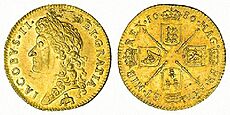
The silver content of sterling stayed mostly the same until 1816. However, the value of gold coins changed. The "guinea" coin was introduced in 1663. It was worth 20 shillings at first. Its value often went above 21 shillings because silver coins were being clipped (shaved down) and hoarded.
In the 17th century, England often paid for imports with silver but received gold for exports. China, for example, wanted silver for its goods. This led to silver leaving England.
During Sir Isaac Newton's time (he was Master of the Mint), the gold guinea was set at 21 shillings in 1717. This made gold the main standard for sterling, even though silver coins were still used.
The Bank of England and Modern Currency
The Bank of England was created in 1694. It started printing banknotes soon after.
Currency of Great Britain (1707) and the United Kingdom (1801)
In 1707, England and Scotland joined to form Great Britain. The Scottish currency was replaced by sterling.
In 1801, Great Britain and Ireland united. The Irish pound was replaced by sterling in 1826.
Sterling in the British Empire
Sterling was used in many parts of the British Empire. Some colonies, like Australia and New Zealand, even created their own "pounds" that were linked to sterling. These areas formed the "sterling area."
However, the early American colonies often used Spanish dollars because of a silver shortage in England.
The Gold Standard
In 1816, Britain officially adopted the gold standard. This meant the value of sterling was directly linked to a certain amount of gold. Silver coins became "token" money, meaning their metal value was less than their face value.
In 1817, the "sovereign" coin was introduced. It was worth 20 shillings and contained a specific amount of gold. It replaced the guinea as the main gold coin.
By the 1800s, sterling banknotes were accepted worldwide. Many other countries also adopted the gold standard. This made it easy to compare currency values based on their gold content. For example, £1 sterling was equal to US$4.87.
World War I: Gold Standard Suspended
The gold standard was stopped when World War I began in 1914. Bank of England notes became the official money. Before the war, Britain had a very strong economy. But after the war, Britain owed a lot of money.
Gold sovereign coins almost stopped being made by 1917. Silver coins were made with less silver in them by 1920.
Between the World Wars: Gold Standard Returns, Then Leaves
To bring back stability, a version of the gold standard was brought back in 1925. You could exchange currency for gold, but not for gold coins. This was stopped on 21 September 1931, during the Great Depression. Sterling's value dropped by about 25%.
Since 1931, sterling has been a fiat money. This means its value is based on people's trust in the economy, not on gold.
World War II
In 1940, an agreement with the US set sterling's value at £1 = US$4.03. This rate was kept during World War II and became part of the Bretton Woods system for exchange rates after the war.
Sterling's Journey (1946–Present)
Bretton Woods System and Devaluations
After World War II, Britain faced economic pressure. On 19 September 1949, the government lowered the pound's value by 30.5% to US$2.80. This was called the "1949 sterling devaluation." Other countries also lowered their currencies against the dollar.
In the 1960s, sterling faced more pressure. In 1966, the government limited how much money tourists could take out of the country. This rule wasn't lifted until 1979. Sterling was lowered again by 14.3% to £1 = US$2.40 in 1967.
Decimalisation: A Big Change
Before 1971, money was counted in pounds, shillings, and pence. For example, £1/12/6 meant one pound, twelve shillings, and six pence.
Ideas to change to a decimal system (like we have now) were first suggested in 1824. In 1848, the "florin" coin was introduced, worth one-tenth of a pound. This was the first step towards decimal money. But full decimalisation was put off for over a hundred years.
Finally, on 15 February 1971, the UK switched to decimal currency. The shilling and old penny were replaced. The pound was divided into 100 "new pence." For example, £1/12/6 became £1.62½. The word "new" was later removed from coins after 1981.
Free-Floating Pound
After the Bretton Woods system ended in 1971, sterling's value was allowed to "float." This means its value changed based on how much people wanted to buy or sell it. The "sterling area" (where other currencies were tied to sterling) also ended around this time.
1976 Sterling Crisis
In 1976, the UK economy faced big problems. Inflation was very high. Financial markets thought the pound was worth too much. The US government worried the crisis could affect international groups like NATO. The International Monetary Fund (IMF) offered a loan but demanded that Britain cut its public spending.
1979–1989
The Conservative government came to power in 1979. They aimed to reduce government spending. Sterling's value went up at first, but then fell sharply after 1980. In March 1985, £1 was worth only US$1.03. It then rose to US$1.70 by 1989.
Following the Deutsche Mark
In 1988, the government tried to make sterling's value follow the Deutsche Mark (Germany's currency). This led to high inflation in the UK.
After Germany reunited in 1990, Germany's borrowing costs were high. This meant interest rates in countries following the Deutsche Mark, like the UK, were too high. This led to a recession in Britain.
Following the European Currency Unit
In 1990, the UK joined the European Exchange Rate Mechanism (ERM). This set the pound's value against other European currencies. However, Britain was forced to leave the ERM on "Black Wednesday" (16 September 1992). This happened because the exchange rate was too high for Britain's economy.
Interest rates jumped to try and stop the pound from falling. But the pound still dropped. Many people later said that a cheaper pound helped British exports and the economy in the 1990s.
Following Inflation Targets
In 1997, the new Labour government gave the Bank of England control over setting interest rates. The Bank's goal is to keep inflation (how fast prices rise) close to 2% per year. If inflation goes too high or too low, the Bank's Governor has to explain why to the government.
The Euro
The UK could have adopted the euro (the currency of many European countries). However, this was always a debated topic in Britain. Many people felt that keeping sterling was important for British identity. The UK decided not to join the euro.
When Cyprus switched to the euro in 2008, the British military bases there also started using the euro. This makes them the only British territory to officially use the euro.
Recent Exchange Rates

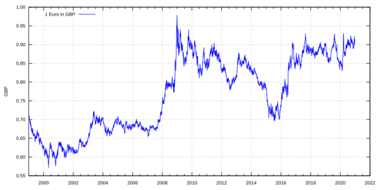
Sterling's value changes against other currencies like the US dollar and the euro. In 2007, sterling reached a 15-year high against the US dollar. It even hit a 26-year high of £1 to US$2.1161 in November 2007.
After the global financial crisis of 2008–2009, sterling's value dropped sharply. In January 2009, £1 was worth US$1.38. It also fell against the euro.
In 2009, the Bank of England started "quantitative easing" (QE). This meant creating new money to buy things like government bonds. The goal was to help the British economy.
The 2016 UK referendum on EU membership (Brexit) caused a big drop in sterling's value. The day after the vote, sterling fell by 5% against the euro. By October 2016, it had fallen 14% against the euro and 16% against the US dollar.
In September 2022, due to inflation and tax cuts, sterling reached its lowest value ever against the US dollar, just over $1.03.
Annual Inflation Rate
The Bank of England aims to keep inflation around 2%. However, inflation has risen and fallen over the years. In September 2011, it reached 5.2%. In November 2021, it was 5.1%.
Coins of the Pound Sterling
Pre-Decimal Coins
The silver penny was the main coin from the 700s to the 1200s. People often cut pennies into halves or quarters for smaller amounts. Later, coins like the "groat" (4d) and "half groat" (2d) were introduced. Gold coins like the "noble" (6 shillings and 8 pence) also appeared.
Henry VII introduced the "shilling" (12 pence) and the "sovereign" (£1 or 20 shillings). Later, the "crown" (5 shillings) and "half crown" (2 shillings and 6 pence) were added. During Henry VIII's reign, coins were made with less precious metal.
After the monarchy was restored in 1660, new coins were made using machines. The "guinea" coin was introduced in 1663. Silver coins became less common in the 1700s. Copper coins like the penny and halfpenny were introduced.
To deal with a shortage of silver coins, the Bank of England stamped Spanish dollars for use as money. In 1816, new silver coins were introduced. The "sovereign" gold coin was brought back in 1817. Copper coins were replaced by bronze in 1860.
During World War I, gold coins were stopped. In 1920, silver coins were made with even less silver. In 1937, a nickel-brass 3d coin was introduced. By 1947, most silver coins were replaced with cupro-nickel. Older coins like the farthing and half-crown were removed from circulation before decimalisation.
Decimal Coins: What We Use Today
| £1 coin (new design, 2016) | |
|---|---|
 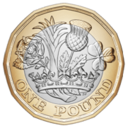 |
|
| Elizabeth II | English rose, Welsh leek, Scottish thistle, and Northern Irish shamrock |
- 1968: The first decimal coins, 5p and 10p, were introduced. They were the same size as the old shilling and florin coins.
- 1969: The 50p coin replaced the ten shilling banknote.
- 1971: Decimalisation was completed. New ½p, 1p, and 2p coins were introduced. Old pennies and threepence coins were removed.
- 1982: The word "new" was removed from coins. A 20p coin was introduced.
- 1983: A round £1 coin was introduced. The ½p coin stopped being made and was removed from circulation in 1984.
- 1990: The crown coin became a £5 commemorative coin. Smaller 5p and 10p coins were introduced, replacing the older, larger ones.
- 1992: 1p and 2p coins started being made from copper-plated steel instead of bronze.
- 1997: A new, smaller 50p coin was introduced.
- 1998: The two-pound (£2) coin was introduced.
- 2008: An extensive redesign of coins was unveiled. The 1p, 2p, 5p, 10p, 20p, and 50p coins featured parts of the Royal Shield. The £1 coin showed the whole shield.
- 2012: 5p and 10p coins changed from cupro-nickel to nickel-plated steel.
- 2017: A new, more secure twelve-sided £1 coin was introduced to prevent fakes. The old round £1 coin was removed from circulation.
As of 2020, the oldest coins still used in the UK are the 1p and 2p copper coins from 1971.
Banknotes of the Pound Sterling
The first sterling banknotes were issued by the Bank of England in 1694. At first, the values were written by hand. Later, notes from £20 to £1,000 were printed. £10 notes were added in 1759, then £5, £1, and £2 notes.
The Bank of Scotland and Royal Bank of Scotland also started issuing notes in Scotland. In the 1800s, Scottish banks were allowed to issue £1 notes, which were not allowed in England.
Private banks in England and Wales used to issue banknotes, but this stopped in 1921. In 1914, the government introduced 10/– and £1 notes to replace gold coins. These were later replaced by Bank of England notes.
During World War II, the Bank of England stopped making notes of £10 and above due to fears of forgery. Scottish and Northern Irish banks continued to issue notes up to £100.
Due to inflation, the Bank of England brought back £10 notes in 1964. In 1969, the 10/– note was replaced by the 50p coin. £20 notes returned in 1970, and £50 notes in 1981. The £1 coin replaced the £1 note in 1983.
UK banknotes have special security features. These include raised print, watermarks, metallic threads, holograms, and ink that glows under UV light.
The Bank of England also produces very large notes called "giant" (£1 million) and "titan" (£100 million). These are only used within the banking system.
Polymer Banknotes
The Northern Bank £5 note in Northern Ireland was the only plastic (polymer) banknote until 2016. The Bank of England started issuing polymer £5 banknotes in September 2016. The paper £5 notes were then removed from circulation.
A polymer £10 banknote was introduced in 2017, followed by a polymer £20 banknote in 2020, and a polymer £50 banknote in 2021.
How Monetary Policy Works
The Bank of England is the central bank of the UK. It sets the rules for the British pound. It does this by controlling how much money is in circulation. The Bank of England is the only one that can issue banknotes in England and Wales. It also regulates seven other banks in Scotland and Northern Ireland that issue banknotes.
The government can give orders to the Bank of England in extreme economic situations, but Parliament must approve these orders.
Unlike banknotes, all British coins are made by the Royal Mint. The Royal Mint is owned by the government and also makes coins for other countries.
Legal Tender and Different Issues
"Legal tender" means that if you owe money, you can pay it in legal tender and the person you owe cannot sue you for not paying. You must offer the exact amount, as the other person doesn't have to give you change.
In the UK, £1 and £2 coins are legal tender for any amount. Other coins are legal tender only for limited amounts. Bank of England notes are legal tender in England and Wales, but not in Scotland or Northern Ireland.
However, banknotes from the Bank of England, Scotland, Northern Ireland, and other places like the Channel Islands can be offered anywhere in the UK. People don't have to accept them, but they often do. For example, shops in England usually accept Scottish notes. Banks will exchange notes from different areas at their face value.
Some special commemorative coins, like £5 coins, are also legal tender, even though you rarely see them used.
| Coin | Maximum usable as legal tender |
|---|---|
| £100 (produced from 2015) | unlimited |
| £20 (produced from 2013) | unlimited |
| £5 (post-1990 crown) | unlimited |
| £2 | unlimited |
| £1 | unlimited |
| 50p | £10 |
| 25p (pre-1990 crown) | £10 |
| 20p | £10 |
| 10p | £5 |
| 5p | £5 |
| 2p | 20p |
| 1p | 20p |
Currencies Linked to Sterling
The Manx pound, Jersey pound, and Guernsey pound are issued by their own governments. They are not controlled by the Bank of England. But they are kept at the same value as the British pound. This means they are like local versions of sterling.
British Overseas Territories like the Falkland Islands, Gibraltar, and Saint Helena also have their own currencies. These are also set to be worth the same as the British pound.
The Value of Sterling Over Time
In 2006, a study showed how prices changed from 1750 to 2005. Before 1914, prices went up and down a lot each year. But there wasn't a steady increase like after 1945.
Since 1945, prices have gone up every year. Overall, prices have increased by more than 27 times. This means that money buys less than it used to.
For example, a shopping basket of goods that cost £10 in 1971 would cost about £163.40 in 2022. This shows how much the buying power of the pound has changed due to inflation.
| Year | Equivalent buying power | Year | Equivalent buying power | Year | Equivalent buying power | Year | Equivalent buying power | Year | Equivalent buying power | Year | Equivalent buying power |
|---|---|---|---|---|---|---|---|---|---|---|---|
| 1971 | £1.00 | 1981 | £0.271 | 1991 | £0.152 | 2001 | £0.117 | 2011 | £0.0900 | 2021 | £0.0678 |
| 1972 | £0.935 | 1982 | £0.250 | 1992 | £0.146 | 2002 | £0.115 | 2012 | £0.0850 | 2022 | £0.0612 |
| 1973 | £0.855 | 1983 | £0.239 | 1993 | £0.144 | 2003 | £0.112 | 2013 | £0.0826 | 2023 | £0.0560 |
| 1974 | £0.735 | 1984 | £0.227 | 1994 | £0.141 | 2004 | £0.109 | 2014 | £0.0800 | ||
| 1975 | £0.592 | 1985 | £0.214 | 1995 | £0.136 | 2005 | £0.106 | 2015 | £0.0780 | ||
| 1976 | £0.510 | 1986 | £0.207 | 1996 | £0.133 | 2006 | £0.102 | 2016 | £0.0777 | ||
| 1977 | £0.439 | 1987 | £0.199 | 1997 | £0.123 | 2007 | £0.0980 | 2017 | £0.0744 | ||
| 1978 | £0.407 | 1988 | £0.190 | 1998 | £0.125 | 2008 | £0.0943 | 2018 | £0.0726 | ||
| 1979 | £0.358 | 1989 | £0.176 | 1999 | £0.123 | 2009 | £0.0952 | 2019 | £0.0707 | ||
| 1980 | £0.303 | 1990 | £0.161 | 2000 | £0.119 | 2010 | £0.0910 | 2020 | £0.0695 |
Exchange Rate and Global Use
Sterling is traded freely in money markets worldwide. Its value changes compared to other currencies.
| Current GBP exchange rates | |
|---|---|
| From Google Finance: | AUD CAD CHF EUR HKD JPY USD |
| From Yahoo! Finance: | AUD CAD CHF EUR HKD JPY USD |
| From XE.com: | AUD CAD CHF EUR HKD JPY USD |
| From OANDA: | AUD CAD CHF EUR HKD JPY USD |
| From fxtop.com: | AUD CAD CHF EUR HKD JPY USD |
Sterling is also used as a reserve currency around the world. This means other countries hold sterling as part of their national savings. As of 2020, it was the fourth most-held reserve currency.
| 2021 | 2020 | 2019 | 2018 | 2017 | 2016 | 2015 | 2014 | 2013 | 2012 | 2011 | 2010 | 2009 | 2008 | 2007 | 2006 | 2005 | 2004 | 2003 | 2002 | 2001 | 2000 | 1995 | 1990 | 1985 | 1980 | 1975 | 1970 | 1965 | |
|---|---|---|---|---|---|---|---|---|---|---|---|---|---|---|---|---|---|---|---|---|---|---|---|---|---|---|---|---|---|
| US dollar | 58.81% | 58.92% | 60.75% | 61.76% | 62.73% | 65.36% | 65.73% | 65.14% | 61.24% | 61.47% | 62.59% | 62.14% | 62.05% | 63.77% | 63.87% | 65.04% | 66.51% | 65.51% | 65.45% | 66.50% | 71.51% | 71.13% | 58.96% | 47.14% | 56.66% | 57.88% | 84.61% | 84.85% | 72.93% |
| Euro (until 1999 - ECU) | 20.64% | 21.29% | 20.59% | 20.67% | 20.17% | 19.14% | 19.14% | 21.20% | 24.20% | 24.05% | 24.40% | 25.71% | 27.66% | 26.21% | 26.14% | 24.99% | 23.89% | 24.68% | 25.03% | 23.65% | 19.18% | 18.29% | 8.53% | 11.64% | 14.00% | 17.46% | |||
| Deutsche mark | 15.75% | 19.83% | 13.74% | 12.92% | 6.62% | 1.94% | 0.17% | ||||||||||||||||||||||
| Japanese yen | 5.57% | 6.03% | 5.87% | 5.19% | 4.90% | 3.95% | 3.75% | 3.54% | 3.82% | 4.09% | 3.61% | 3.66% | 2.90% | 3.47% | 3.18% | 3.46% | 3.96% | 4.28% | 4.42% | 4.94% | 5.04% | 6.06% | 6.77% | 9.40% | 8.69% | 3.93% | 0.61% | ||
| Pound sterling | 4.78% | 4.73% | 4.64% | 4.43% | 4.54% | 4.35% | 4.71% | 3.70% | 3.98% | 4.04% | 3.83% | 3.94% | 4.25% | 4.22% | 4.82% | 4.52% | 3.75% | 3.49% | 2.86% | 2.92% | 2.70% | 2.75% | 2.11% | 2.39% | 2.03% | 2.40% | 3.42% | 11.36% | 25.76% |
| Chinese renminbi | 2.79% | 2.29% | 1.94% | 1.89% | 1.23% | 1.08% | |||||||||||||||||||||||
| Canadian dollar | 2.38% | 2.08% | 1.86% | 1.84% | 2.03% | 1.94% | 1.77% | 1.75% | 1.83% | 1.42% | |||||||||||||||||||
| French franc | 2.35% | 2.71% | 0.58% | 0.97% | 1.16% | 0.73% | 1.11% | ||||||||||||||||||||||
| Australian dollar | 1.81% | 1.83% | 1.70% | 1.63% | 1.80% | 1.69% | 1.77% | 1.59% | 1.82% | 1.46% | |||||||||||||||||||
| Swiss franc | 0.20% | 0.17% | 0.15% | 0.14% | 0.18% | 0.16% | 0.27% | 0.24% | 0.27% | 0.21% | 0.08% | 0.13% | 0.12% | 0.14% | 0.16% | 0.17% | 0.15% | 0.17% | 0.23% | 0.41% | 0.25% | 0.27% | 0.33% | 0.84% | 1.40% | 2.25% | 1.34% | 0.61% | |
| Dutch guilder | 0.32% | 1.15% | 0.78% | 0.89% | 0.66% | 0.08% | |||||||||||||||||||||||
| Other currencies | 3.01% | 2.65% | 2.51% | 2.45% | 2.43% | 2.33% | 2.86% | 2.83% | 2.84% | 3.26% | 5.49% | 4.43% | 3.04% | 2.20% | 1.83% | 1.81% | 1.74% | 1.87% | 2.01% | 1.58% | 1.31% | 1.49% | 4.87% | 4.89% | 2.13% | 1.29% | 1.58% | 0.43% | 0.03% |
| Source: World Currency Composition of Official Foreign Exchange Reserves: http://data.imf.org/regular.aspx?key=41175 International Monetary Fund | |||||||||||||||||||||||||||||
Images for kids
See also
 In Spanish: Libra esterlina para niños
In Spanish: Libra esterlina para niños


